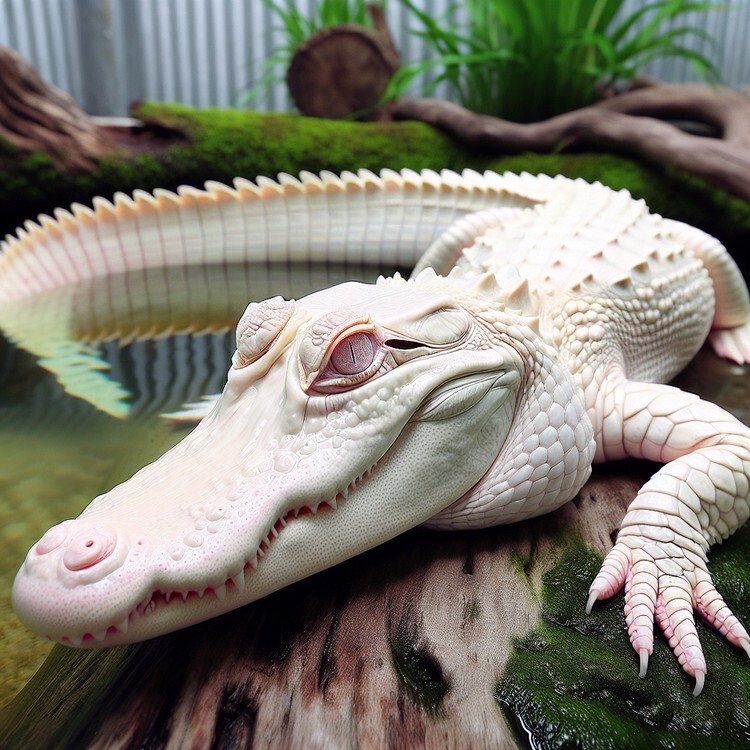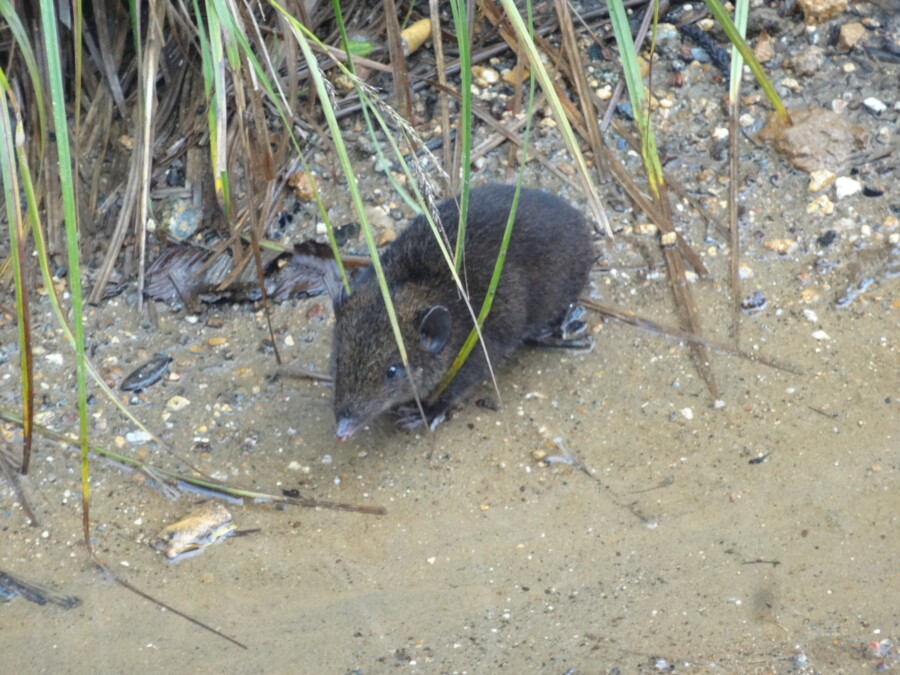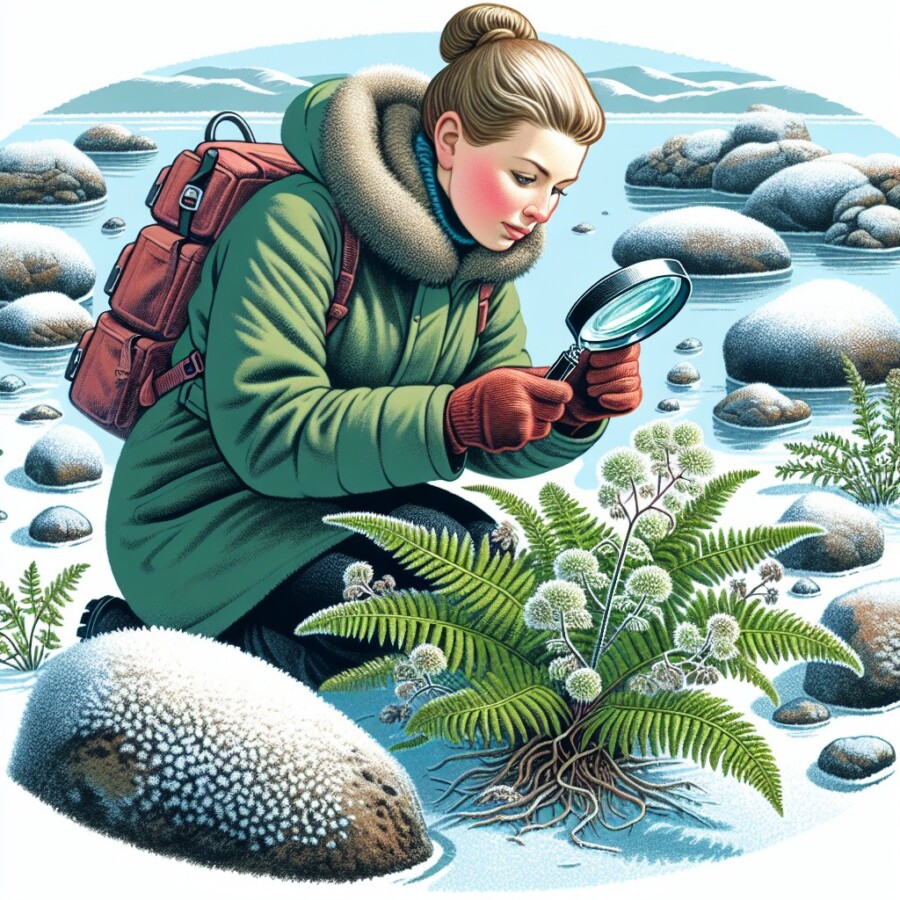An incredibly rare alligator has recently been born at a wildlife park in Orlando, Florida. This female reptile, measuring 49cm (19.2 inches), is one of only seven leucistic alligators in the entire world. Leucistic alligators are the rarest genetic variation of American alligators. Unlike albino alligators, which have pink eyes and a complete loss of pigment, leucistic alligators have a partial loss of pigment. Mark McHugh, the president and CEO of Gatorland, described this event as “beyond rare” and “absolutely extraordinary.”
Leucistic alligators are a unique and fascinating sight to behold. Their pale, almost white appearance sets them apart from their more common counterparts. This particular alligator’s birth has garnered significant attention and excitement from both experts and the public alike. It is a testament to the incredible diversity and wonder of the natural world.
The birth of this rare alligator serves as a reminder of the importance of wildlife conservation efforts. It highlights the need to protect and preserve these extraordinary creatures and their habitats. The wildlife park where the alligator was born plays a crucial role in educating the public about the importance of conservation and raising awareness about the incredible biodiversity that exists in our world.
As one of only seven leucistic alligators in existence, this baby alligator is a true marvel of nature. Its birth is a cause for celebration and a reminder of the beauty and uniqueness that can be found in the animal kingdom. It is a testament to the wonders of nature and the importance of preserving and protecting these rare and extraordinary species for future generations to appreciate and admire.
Original news source: See ‘beyond rare’ white baby alligator born in US (BBC)
Listen:
Slow
Normal
Fast
Vocabulary:
| 1 | leucistic | Having a partial loss of pigment |
| 2 | genetic | Relating to genes or heredity |
| 3 | variation | A difference or change in form, condition, or appearance |
| 4 | pigment | A substance that gives color to the skin, hair, and eyes |
| 5 | counterparts | People or things that are similar or equivalent to each other |
| 6 | garnered | Gathered or collected |
| 7 | testament | Evidence or proof of something |
| 8 | biodiversity | The variety of different living organisms in a particular area |
| 9 | marvel | Something that causes wonder or astonishment |
| 10 | appreciation | Recognition and understanding of the value or significance of something |
| 11 | admire | Regard with respect, pleasure, or approval |
| 12 | conservation | The protection and preservation of the natural environment |
| 13 | preserve | Keep in its original state or in good condition |
| 14 | habitats | The natural home or environment of an animal, plant, or other organism |
| 15 | species | A group of living organisms consisting of similar individuals |
Group or Classroom Activities
Warm-up Activities:
– News Summary
Instructions:
1. Divide the class into small groups.
2. Give each group a copy of the article.
3. Instruct each group to read the article and summarize the main points in a brief news summary.
4. Encourage groups to focus on the key information and use their own words to summarize the article.
5. After a designated amount of time, have each group share their news summary with the class.
– Opinion Poll
Instructions:
1. Divide the class into pairs.
2. Assign one person in each pair as the interviewer and the other as the interviewee.
3. Provide a list of discussion questions related to the article, such as “What are your thoughts on the importance of wildlife conservation?”
4. Instruct the interviewers to ask the questions to their partners and record their responses.
5. After a certain amount of time, have the pairs switch roles and repeat the process.
6. Once everyone has had a chance to be both interviewer and interviewee, have a class discussion to share and compare opinions.
– Sketch It
Instructions:
1. Provide each student with a blank sheet of paper and a pencil.
2. Instruct the students to read the article and choose one specific detail or aspect of the story that they find interesting.
3. Ask the students to sketch their chosen detail or aspect on the paper.
4. After a designated amount of time, have the students share their sketches with the class.
5. Encourage the students to explain their sketches and discuss why they found that particular detail or aspect interesting.
– Vocabulary Pictionary
Instructions:
1. Divide the class into two teams.
2. Provide a list of vocabulary words from the article, such as “leucistic,” “genetic variation,” and “biodiversity.”
3. Have one team member from each team come to the front of the class.
4. Show the chosen word to the two students at the front, without the rest of the class seeing it.
5. Instruct the students to draw a quick sketch of the word on the board, while their team members try to guess the word.
6. The first team to correctly guess the word gets a point.
7. Repeat the process with new team members and new vocabulary words until all the words have been used.
– Pros and Cons
Instructions:
1. Divide the class into pairs.
2. Assign one person in each pair as the “pro” and the other as the “con.”
3. Instruct the pairs to read the article and discuss the pros and cons of wildlife conservation efforts.
4. Encourage students to consider different perspectives and come up with compelling arguments for both sides.
5. After a designated amount of time, have pairs share their arguments with the class.
6. Facilitate a class discussion to explore the different viewpoints and encourage critical thinking.
Comprehension Questions:
1. How does a leucistic alligator differ from an albino alligator?
2. Why is the birth of this leucistic alligator considered “beyond rare”?
3. What sets leucistic alligators apart from their more common counterparts?
4. What kind of attention has the birth of this alligator garnered?
5. What does the birth of this rare alligator remind us about?
6. What role does the wildlife park play in conservation efforts?
7. How many leucistic alligators are there in the entire world?
8. Why is the birth of this baby alligator considered a marvel of nature?
Go to answers ⇩
Listen and Fill in the Gaps:
An incredibly rare alligator has recently been born at a (1)______ park in Orlando, Florida. This female reptile, measuring 49cm (19.2 inches), is one of only seven (2)______ alligators in the entire world. Leucistic alligators are the rarest (3)______ variation of American alligators. Unlike albino alligators, which have pink eyes and a complete loss of (4)______, leucistic alligators have a partial loss of pigment. Mark McHugh, the president and CEO of Gatorland, described this event as “beyond rare” and “absolutely extraordinary.”
Leucistic alligators are a (5)______ and fascinating sight to behold. Their pale, almost white (6)______ sets them apart from their more common counterparts. This particular alligator’s birth has (7)______ significant (8)______ and excitement from both experts and the public alike. It is a testament to the incredible diversity and (9)______ of the natural (10)______.
The (11)______ of this rare alligator serves as a reminder of the importance of wildlife conservation efforts. It highlights the need to protect and preserve these extraordinary creatures and their habitats. The wildlife park where the alligator was born plays a crucial role in educating the public about the importance of conservation and raising awareness about the (12)______ biodiversity that exists in our world.
As one of only seven leucistic (13)______s in (14)______, this baby alligator is a true marvel of nature. Its birth is a (15)______ for celebration and a reminder of the (16)______ and uniqueness that can be found in the animal kingdom. It is a testament to the wonders of nature and the importance of preserving and protecting these rare and extraordinary species for future generations to appreciate and admire.
Go to answers ⇩
Discussion Questions:
Students can ask a partner these questions, or discuss them as a group.
1. What is a leucistic alligator and how is it different from an albino alligator?
2. How would you feel if you saw a leucistic alligator in person? Why?
3. Do you think it is important to protect and preserve rare and unique species like the leucistic alligator? Why or why not?
4. Have you ever seen a rare or unique animal? If so, how did it make you feel?
5. What do you think is the significance of the birth of this rare alligator in terms of wildlife conservation efforts?
6. Do you think wildlife parks and zoos have a role to play in educating the public about conservation? Why or why not?
7. How do you think the public’s fascination with rare and unique animals like the leucistic alligator can help raise awareness about biodiversity?
8. What other rare or unique animals would you like to see in person? Why?
9. Do you think it is important for future generations to appreciate and admire rare and extraordinary species? Why or why not?
10. How do you think the birth of this rare alligator can inspire people to get involved in wildlife conservation efforts?
11. Have you ever visited a wildlife park or zoo that focuses on conservation? If so, what did you learn from your visit?
12. What do you think is the role of humans in preserving and protecting rare and extraordinary species?
13. How do you think the birth of this rare alligator can impact scientific research and understanding of genetic variations in alligators?
14. Would you like to have a rare or unique animal as a pet? Why or why not?
15. How do you think the birth of this rare alligator can influence public attitudes towards wildlife conservation and the importance of protecting biodiversity?
Individual Activities
Vocabulary Meanings:
Match each word to its meaning.
Words:
1. leucistic
2. genetic
3. variation
4. pigment
5. counterparts
6. garnered
7. testament
8. biodiversity
9. marvel
10. appreciation
11. admire
12. conservation
13. preserve
14. habitats
15. species
Meanings:
(A) Recognition and understanding of the value or significance of something
(B) Evidence or proof of something
(C) A substance that gives color to the skin, hair, and eyes
(D) The natural home or environment of an animal, plant, or other organism
(E) Keep in its original state or in good condition
(F) Regard with respect, pleasure, or approval
(G) Having a partial loss of pigment
(H) People or things that are similar or equivalent to each other
(I) Something that causes wonder or astonishment
(J) Gathered or collected
(K) A group of living organisms consisting of similar individuals
(L) The protection and preservation of the natural environment
(M) Relating to genes or heredity
(N) The variety of different living organisms in a particular area
(O) A difference or change in form, condition, or appearance
Go to answers ⇩
Multiple Choice Questions:
1. What is the genetic variation of the alligator mentioned in the article?
(a) Albino
(b) Leucistic
(c) Melanistic
(d) Heterozygous
2. How many leucistic alligators are there in the world?
(a) Ten
(b) Twenty
(c) Seven
(d) Fifty
3. How does a leucistic alligator differ from an albino alligator?
(a) Leucistic alligators have a partial loss of pigment, while albino alligators have a complete loss of pigment.
(b) Leucistic alligators have pink eyes, while albino alligators have normal colored eyes.
(c) Leucistic alligators are smaller in size than albino alligators.
(d) Leucistic alligators have a complete loss of pigment, while albino alligators have a partial loss of pigment.
4. What is the name of the wildlife park where the rare alligator was born?
(a) Orlando Park
(b) Gatorland
(c) Alligator World
(d) Florida Wildlife Park
5. What is the CEO of Gatorland’s opinion of the birth of the rare alligator?
(a) It is “beyond rare” and “absolutely extraordinary.”
(b) It is “common” and “unremarkable.”
(c) It is “expected” and “ordinary.”
(d) It is “disappointing” and “unimportant.”
6. What does the birth of the rare alligator highlight the need for?
(a) More alligator breeding programs
(b) Increased tourism in Orlando
(c) Hunting of alligators
(d) Wildlife conservation efforts
7. What role does the wildlife park play in regards to conservation?
(a) Capturing and selling rare alligators
(b) Destroying alligator habitats
(c) Encouraging alligator hunting
(d) Educating the public and raising awareness about the importance of conservation
8. What does the article describe the birth of the rare alligator as?
(a) A common occurrence
(b) A disappointment
(c) A true marvel of nature
(d) A sign of overpopulation
Go to answers ⇩
True or False Questions:
1. Leucistic alligators have a complete loss of pigment, like albino alligators.
2. A rare alligator has recently been born at a wildlife park in Orlando, Florida.
3. This alligator is one of only three leucistic alligators in the world.
4. The birth of this alligator highlights the importance of wildlife conservation efforts.
5. The birth of this alligator has gone unnoticed and generated little excitement.
6. Leucistic alligators have a pale, almost white appearance.
7. The wildlife park where the alligator was born does not prioritize educating the public about conservation.
8. This alligator’s birth is a testament to the beauty and uniqueness of the animal kingdom.
Go to answers ⇩
Write a Summary:
Write a summary of this news article in two sentences.
Check your writing now with the best free AI for English writing!
Writing Questions:
Answer the following questions. Write as much as you can for each answer.
Check your answers with our free English writing assistant!
1. What makes leucistic alligators different from albino alligators?
2. Why is the birth of this rare alligator significant?
3. What does the birth of this alligator remind us about the importance of?
4. How does the wildlife park play a role in conservation efforts?
5. Why is the birth of this alligator considered a marvel of nature?
Answers
Comprehension Question Answers:
1. A leucistic alligator has a partial loss of pigment, while an albino alligator has a complete loss of pigment and pink eyes.
2. The birth of this leucistic alligator is considered “beyond rare” because there are only seven leucistic alligators in the entire world.
3. Leucistic alligators have a pale, almost white appearance, which sets them apart from their more common counterparts.
4. The birth of this alligator has garnered significant attention and excitement from both experts and the public.
5. The birth of this rare alligator reminds us about the importance of wildlife conservation efforts and the need to protect and preserve these extraordinary creatures and their habitats.
6. The wildlife park plays a crucial role in educating the public about the importance of conservation and raising awareness about the incredible biodiversity that exists in our world.
7. There are only seven leucistic alligators in the entire world.
8. The birth of this baby alligator is considered a marvel of nature because it is incredibly rare and showcases the beauty and uniqueness that can be found in the animal kingdom.
Go back to questions ⇧
Listen and Fill in the Gaps Answers:
(1) wildlife
(2) leucistic
(3) genetic
(4) pigment
(5) unique
(6) appearance
(7) garnered
(8) attention
(9) wonder
(10) world
(11) birth
(12) incredible
(13) alligator
(14) existence
(15) cause
(16) beauty
Go back to questions ⇧
Vocabulary Meanings Answers:
1. leucistic
Answer: (G) Having a partial loss of pigment
2. genetic
Answer: (M) Relating to genes or heredity
3. variation
Answer: (O) A difference or change in form, condition, or appearance
4. pigment
Answer: (C) A substance that gives color to the skin, hair, and eyes
5. counterparts
Answer: (H) People or things that are similar or equivalent to each other
6. garnered
Answer: (J) Gathered or collected
7. testament
Answer: (B) Evidence or proof of something
8. biodiversity
Answer: (N) The variety of different living organisms in a particular area
9. marvel
Answer: (I) Something that causes wonder or astonishment
10. appreciation
Answer: (A) Recognition and understanding of the value or significance of something
11. admire
Answer: (F) Regard with respect, pleasure, or approval
12. conservation
Answer: (L) The protection and preservation of the natural environment
13. preserve
Answer: (E) Keep in its original state or in good condition
14. habitats
Answer: (D) The natural home or environment of an animal, plant, or other organism
15. species
Answer: (K) A group of living organisms consisting of similar individuals
Go back to questions ⇧
Multiple Choice Answers:
1. What is the genetic variation of the alligator mentioned in the article?
Answer: (b) Leucistic
2. How many leucistic alligators are there in the world?
Answer: (c) Seven
3. How does a leucistic alligator differ from an albino alligator?
Answer: (a) Leucistic alligators have a partial loss of pigment, while albino alligators have a complete loss of pigment.
4. What is the name of the wildlife park where the rare alligator was born?
Answer: (b) Gatorland
5. What is the CEO of Gatorland’s opinion of the birth of the rare alligator?
Answer: (a) It is “beyond rare” and “absolutely extraordinary.”
6. What does the birth of the rare alligator highlight the need for?
Answer: (d) Wildlife conservation efforts
7. What role does the wildlife park play in regards to conservation?
Answer: (d) Educating the public and raising awareness about the importance of conservation
8. What does the article describe the birth of the rare alligator as?
Answer: (c) A true marvel of nature
Go back to questions ⇧
True or False Answers:
1. Leucistic alligators have a complete loss of pigment, like albino alligators. (Answer: False)
2. A rare alligator has recently been born at a wildlife park in Orlando, Florida. (Answer: True)
3. This alligator is one of only three leucistic alligators in the world. (Answer: False)
4. The birth of this alligator highlights the importance of wildlife conservation efforts. (Answer: True)
5. The birth of this alligator has gone unnoticed and generated little excitement. (Answer: False)
6. Leucistic alligators have a pale, almost white appearance. (Answer: True)
7. The wildlife park where the alligator was born does not prioritize educating the public about conservation. (Answer: False)
8. This alligator’s birth is a testament to the beauty and uniqueness of the animal kingdom. (Answer: True)
Go back to questions ⇧













